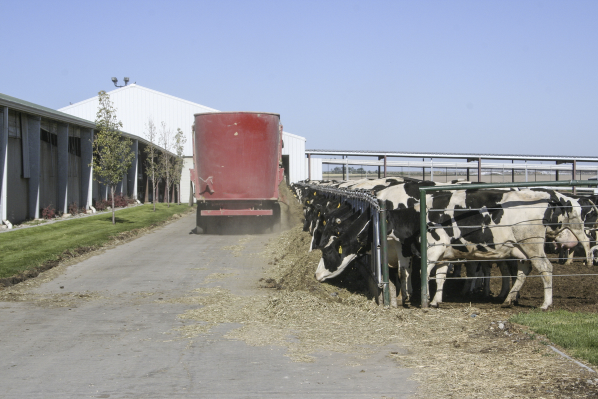When it comes to creating consistency in feeding and nutrition, there are three key areas to consider:
- Feedstuff harvest and storage
- Mixing and delivery
- Managing the rumen
Start in storage
The path to consistency starts in the way feeds are harvested, purchased and stored.
Although nature can get in the way, it’s important to get forages harvested quickly to reduce the range in nutrient quality, digestibility and dry matter. Likewise, the storage process needs to create a well-preserved forage across the bunker, pad, bag or silo so each batch of forage is similar.
Storage is also important with commodity feeds to reduce shrink. However, variability can creep in through supply inconsistencies. For example, one load of dry distillers can be significantly different than the next due to any number of variables within which it was produced at the manufacturing facility. To reduce this variation, it is best to work with a reputable supplier dedicated to producing consistent product. Sometimes consistency comes with a higher price tag, but it can be worth the investment if cows are more content.
Mix and deliver
When forages are harvested and stored properly and commodities sourced and stored to reduce variability, the next area where inconsistency can creep in is through the mixing and delivery process. Here are a few tips on how to reduce variability in this process:
-
Protocols: It’s critical to have protocols in place to provide guidance in the mixing and delivery process, and make sure those protocols are being followed.
-
Take dry matters: Even though forages might be consistent from a storage and quality standpoint, it’s important to assess dry matter content on a daily basis. Even small variations in dry matter can have a significant impact on the amount of feed mixed and delivered, causing either over or underdelivery of feed.
-
Maintain the mixer: Next to the parlor, the mixer wagon is the most-used piece of equipment on the dairy. It’s important to keep it maintained so rations from every batch are mixed consistently and properly.
-
Deliver feed on time, every time: As important as proper mixing is to consistent rations, delivery of those rations can be even more important so cows don’t run out of feed. Make sure protocols are followed closely so feeds are delivered at the same time every day. And once they have been delivered, make sure feed gets pushed up on a regular basis throughout the day so feed is available at all times.
- Document pen changes: If cows are moved from one pen to another, make sure that change is reflected in the feeding software. Feeding too much feed might have more impact than wasted feed, but feeding not enough of a ration can cause empty bunks and cows to go off feed for a considerable amount of time.
Manage the rumen
We have gotten to the point in the feeding process where feeds are harvested and stored in a way that limits shrink and spoilage while allowing forages to properly ferment. We also have solid protocols that are followed closely so feeds are mixed properly and delivered at the same time each day. Next, we need to make sure the rumen is well-balanced and ready to consume the diet.
The most important aspect of managing the rumen is proper calculation and balancing of the diet. Gone are the days when rations were calculated by hand, which allowed human error to cause miscalculations. Today, nearly everything is done with computer technology so the ration that gets printed is generally accurate.
Those rations take into account the microbial population and how nutrients are digested in the rumen and gastrointestinal tract (GI), in addition to the general environment inside the rumen. Make sure these products are in your ration to maintain rumen consistency:
-
Buffers: Most rations include rumen buffers, but not enough feed them at the proper level. Today’s high-producing cows need a pound of buffers each day to help maintain a proper rumen pH and account for any variability in sorting.
-
Refined functional carbohydrates (RFCs): There is a lot of activity inside the cow, the rumen and the gut. RFCs can help animals cope with environmental challenges that could be impacting the cow. This includes controlling the impact of mycotoxins on gut health.
- Protect against contaminants: Pathogens like salmonella, E. coli and clostridia can have a significant impact on cow health. While these pathogens are generally present in any environment, it’s important to reduce pathogen loads whenever possible. For example, pay attention to commodities delivered to your feeding center. While you may get a load of whole cottonseed that looks good, you don’t know what that truck and trailer was used to haul prior to the load that ended up on your dairy. Those situations create significant opportunities for pathogen contamination. Using a bacillus-based feed ingredient can help reduce incidence of pathogens, including clostridia, in your nutrition system.
Consistency is king when it comes to dairy cows. They like to be managed the same way, every day. When something happens to change that schedule, bad things happen. By focusing on the basics of proper harvest and storage, following mixing and feed protocols, and getting the rumen and gut ready for high planes of nutrition, you can avoid some of the variation pitfalls dairy producers face.
-
Joel Pankowski
- Senior Manager, Dairy Technical Services
- Arm & Hammer Animal and Food Production
- Email Joel Pankowski








